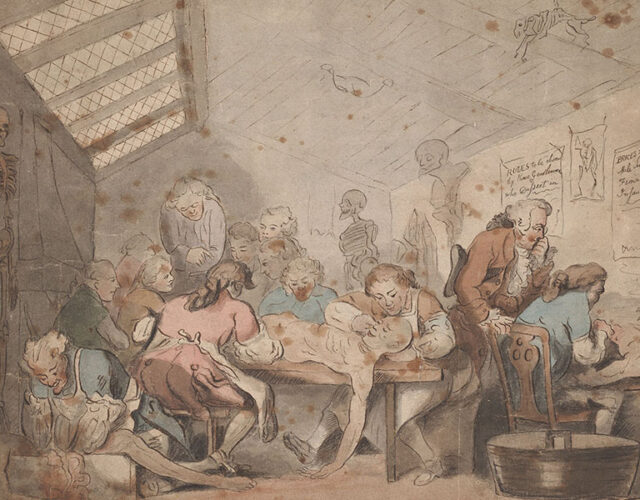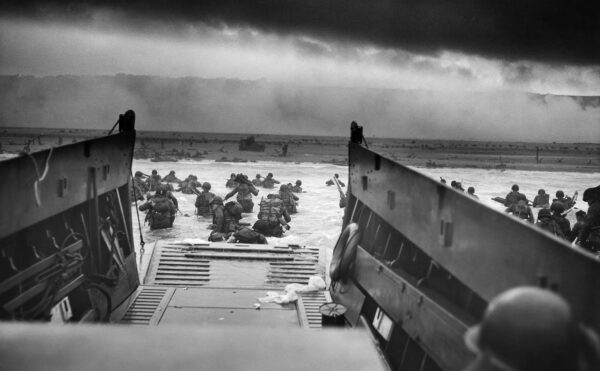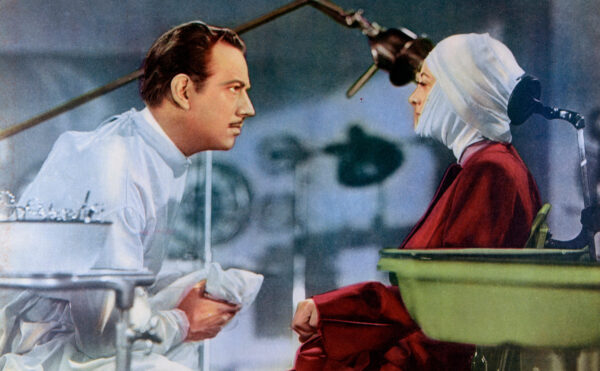In the 1700s human dissection was a big taboo—people feared that it would leave their bodies mangled on Judgment Day, when God would raise the dead. As a result, government officials banned most dissections. This led to some unintended consequences, most notably a shortage of bodies for anatomists to dissect. To meet the heightened demand, a new profession emerged: grave-robbers. These so-called resurrectionists dug up the bodies of poor people to sell to anatomists, which led to riots in the streets.
Credits
Host: Sam Kean
Senior Producer: Mariel Carr
Producer: Rigoberto Hernandez
Audio Engineer: Jonathan Pfeffer
Photo: Osler Library of the History of Medicine, McGill University
Transcript
Sam Kean:
According to legend, America’s first anatomy riot started with a crass joke.
It was a spring afternoon, in 1788. A medical student at New York’s General Hospital was dissecting a woman’s body in a lab there, cutting into her arm with a scalpel.
Suddenly, he realized he wasn’t alone. A gang of boys was peeking into the window—gawking wide-eyed at a real-life dead person.
Their gaping annoyed the student, who wanted to work in peace. So, to spook the boys, he reportedly grabbed the flayed arm in front of him and waved it at them. Yoo-hoo! Then he hollered, “This is your mother’s arm. I just dug it up!”
Har har. Unfortunately, one of the boys had just lost his mother. And he ran straight home to his father, bawling. The father in turn marched out to his late wife’s grave with a shovel and started digging.
He got to the bottom, and found exactly what he expected. Nothing. Her grave was empty.
He marched back home furious. And the thing was, he wasn’t alone. There were hundreds of other people in New York who were every bit as furious with the doctors at the hospital. They were sick and tired of abuse at the hands of the scientific body-snatchers.
From the Science History Institute this is Sam Kean and the Disappearing Spoon—a topsy-turvy science-y history podcast. Where footnotes become the real story.
The roots of American anatomy riots trace back to Great Britain.
Throughout the 1700s people in Britain feared that dissection after death would leave their bodies mangled on Judgment Day, when God would raise the dead. Britons also viewed dissection as shameful—a naked body lying there, poked and prodded. So government officials banned dissections there.
Still, the British crown knew that doctors needed bodies for training and medical research. So the government did supply medical schools with a few executed criminals. In fact, judges would explicitly sentence criminals to death and dissection as a way to wring a little more punishment out of the rogues after death.
Unfortunately, these sentences often led to unseemly scenes at public hangings. There were so few bodies available, and so much demand for them, that anatomy students from rival schools often got into fistfights over corpses. In their haste, students sometimes even yanked people off the gallows who weren’t dead yet. Their necks hadn’t broken in the drop, and they’d merely passed out from lack of air—only to pop awake again at the last second on the dissection table.
Given the shortage of bodies, British anatomists felt that, to push their science forward, they had no choice but to rob graves. Sometimes they enlisted their students for help. Being students, they’d get stinking drunk and storm the local churchyard after midnight for fresh bodies. To them, it was all a ghoulish game.
Other anatomists outsourced the work to professionals—fulltime grave-robbers called resurrectionists.
The best resurrectionists could expose a coffin and strip the body out in fifteen minutes flat. Then they’d then schlep the body across town and slink into an alley behind an anatomist’s house. They typically got two pounds per body—about $250 today. It was good money. In Scotland, two enterprising fellows even started murdering people and selling those bodies, just for extra cash.
The occasional murder aside, the British government mostly looked the other way at body-snatching. Again, officials knew that young doctors and surgeons needed bodies to train with. Otherwise, they’d be learning anatomy on the fly, perhaps while elbow-deep inside living people—a ghastly possibility.
Plus, it was easy for officials to look the other way, since it wasn’t their loved ones being stolen. It was poor people.
Rich families could afford deterrents against grave-robbing, like so-called mortsafes. These iron cages surrounded the coffins underground and made the bodies hard to steal. The rich also hired private guards to watch over their dearly departed. The poor, meanwhile, couldn’t afford these defenses. So anatomists and grave-robbers preyed on them.
Now, as a former British colony, the United States inherited most British traditions. This included both the popular prejudice against dissections, as well as the scientific justification for robbing graves.
And just like across the Pond, the poor suffered most of the consequences in America. The hardest hit groups here included American Indians; immigrants, especially German and Irish immigrants; and black people, both enslaved and free.
As a result of all this, there was widespread hatred for doctors and anatomists in New York City by 1788. Now, we don’t know whether the medical student who waved the flayed arm had actually robbed the grave of the boy’s mother. Perhaps someone else did, or perhaps the body disappeared for another reason.
The boy’s father didn’t care. His wife was missing, and someone was going to pay. And when he storming the hospital, hordes of people rallied to his side. People who’d seen their own wives go missing, or their sons or aunts, or who were simply sick of being exploited. For once, they decided to see how the rich doctors liked having their guts spilled.
The mob arrived at the hospital hundreds of people strong. Upon seeing them, the doctors and anatomists panicked. Most fled on foot. One scampered up a chimney. The mob proceeded to take over the building, dragging equipment into the street to smash it and dragging specimens outside to burn them. The mob also grabbed several stolen bodies inside in various states of decay and reburied them.
Trashing the hospital didn’t quench the mob’s anger, however. In fact, as news about the mob spread, its numbers swelled overnight. The next day several thousand people marched on another medical building, at Columbia University. Alexander Hamilton himself had to stand on the steps and beg them not to destroy it.
In the meantime, New York City’s mayor had jailed several medical scientists for their own safety, since the prison was the stoutest building in town. The mob wasn’t deterred, however. Five thousand people eventually gathered outside the prison, smashing its windows and tearing down a fence. Several people were heard to howl, “Bring out yer doctors!”
However tense, things still might have ended peacefully if not for what happened next. At dusk, the terrified mayor called in the militia. He also begged local political leaders to come by and help restore order. These leaders included a Revolutionary War general and John Jay, a future Chief Justice of the Supreme Court.
Jay and the general pleaded with the mob for peace. The crowd was unmoved. What did rich bastards like them know about having their loved ones go missing?
Suddenly a rock streaked through the air. It clobbered John Jay in the skull, cracking his head open. Then a brick came flying in and beaned the Revolutionary War general. And as he staggered back, bloody and dazed, the general hissed at the mayor to have the militia fire already.
Technically, this wasn’t an order, just a suggestion. But the soldiers were already spooked, and didn’t need any more encouragement. When the general said fire, they snapped their rifles up and let loose on the crowd.
Suddenly, there was bedlam in the street. Bravely, a few commoners rushed the militia and attacked them, and things were no doubt touch and go for a few minutes.
But the soldiers’ firepower won out. They quickly dispersed the mob and ended the riot. The exact casualties remain unknown. But according to some reports, by the time the smoke cleared, twenty dead bodies were lying in the street. The riot had started over one corpse, and ended with many more. The bodies, presumably, were buried.
The New York riot was hardly an anomaly. At least 17 American anatomy riots took place before the U.S. Civil War—in Connecticut and Boston, in Baltimore and Philadelphia, in Cleveland and St. Louis. And body-snatching itself was practiced nationwide for much of the 1800s.
The most notorious body-snatch involved U.S. Senator John Harrison of Ohio. He was the son of former president William Henry Harrison and the father of future president Benjamin Harrison. But to resurrectionists, he was just a payday. So after his death in 1878, Harrison was dug up, stripped naked, and laid out for dissection. His family had to storm into the local hospital at the last second to save him.
Eventually, the pleas from doctors for more bodies to dissect got to be too much—as did the continual threat of more riots. So in the 1800s most U.S. states passed so-called anatomy acts or “bone bills.” These laws allowed medical schools to take unclaimed bodies from hospitals and poorhouses and dissect them, rather than dig bodies out of graves. This quieted the popular fury.
But if the bone bills cut down on the riots, these laws still seemed ethically dubious to many people, even at the time. Because once again, the burden for supplying bodies for science fell exclusively on the poor. After all, it wasn’t the well-heeled and well-connected who were dying unclaimed in poorhouses.
Given the state of society at the time, perhaps the bone bills were the best compromise that could be expected. But here’s the thing about this story that really grabs me. It’s clear in retrospect that using unclaimed bodies was not only ethically dicey but scientifically dubious as well. Because, as crazy as this sounds, poor people can actually have different anatomies.
Compared to the middle and upper classes, poor people suffer from chronic stress at much higher rates, stress of all kinds. Poor people generally have worse health, for instance, and are exposed to more pollutants. And especially back in the 1800s, many of them faced eviction and starvation on a regular basis.
Now, one way the body deals with stress is by pumping out hormones like cortisol and adrenaline. Specifically, these hormones are pumped out by certain glands. And when these glands are constantly in overdrive, their size and shape can change.
Some of these glands swell in size, like overworked muscles. Other glands exhaust themselves and shrivel up.
Can you see the trap here? Doctors back then learned anatomy by dissecting poor people. But poor people who endured constant stress often had shriveled or enlarged glands. As a result, the doctors who dissected them had a distorted view of what those glands should look like. There was systematic error in their science.
This wasn’t just an academic worry, either. It had real, deadly consequences.
In the 1800s scores of babies started dying from what we now call SIDS—sudden infant death syndrome. Naturally, doctors wanted to know the cause. So they started performing autopsies on SIDS babies. And they noticed that most SIDS babies had one gland in particular that looked enormous, the thymus glands in their chests.
In reality, these were normal thymus glands. They only seemed large compared to the wilted thymus glands that doctors usually found in babies from poor families. These poor babies had often died of chronic and stressful ailments like diarrhea or malnutrition. SIDS babies, in contrast, died suddenly by definition—before diarrhea or malnutrition could alter their glands. As a result, their thymus glands were normal sized.
But doctors didn’t know this. And they developed a theory that SIDS was caused by gargantuan thymus glands, which were supposedly suffocating babies by crushing their windpipes. And here’s where things turned deadly. Because in the early 1900s many doctors began blasting babies’ thymus glands with radiation, in order to shrink them.
Thousands upon thousands of children suffered radiation burns as a result, not to mention depleted glands and depleted hormones. Many also developed cancer later in life, leading to an estimated 10,000 premature deaths. Exploiting the poor was unethical in the first place. But it’s a sad example of how an unethical scientific setup can lead to shoddy scientific results as well.
Ultimately, we don’t know whether the cadaver who sparked the New York anatomy riot in 1788 was that boy’s mother. But she was somebody’s mother or somebody’s daughter or somebody’s dear friend. The medical student meant no harm in waving the flayed arm. He just wanted to scare the boys and get back to doing science. But to those on the outside looking in, his little joke seemed more like a matter of life and death.




